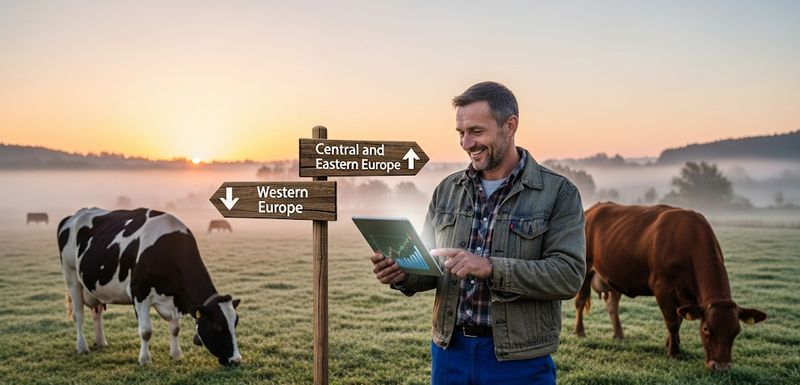
Europe's Meat Market Tilts East
Analysis shows how central and eastern European producers can capitalise on their strategic advantages as Western European suppliers face a historic squeeze
A significant realignment is underway in the European Union's meat sector. Producers in Central and Eastern Europe (CEE) find themselves in an increasingly advantageous position as traditional Western European powerhouses face mounting internal pressures. A recent analysis of EU pricing data by Martina Osmak of Meat Borsa highlights a widening gap, presenting both clear opportunities and strategic imperatives for the CEE region's meat industry. The current market dynamics suggest that a combination of inherent cost advantages and new digital tools could fuel substantial growth for producers who act decisively.
Key Takeaways
CEE's Unmatched Price Advantage: Central and Eastern European countries like Poland and Romania have a significant structural price advantage, offering the most competitively priced meat in the EU.
Western Europe's Supply Squeeze: Major producers in France and Germany are facing intense margin pressure and declining production, creating a reliable supply gap in the market.
Digital Marketplaces are Key: Online B2B platforms like Meat Borsa are crucial tools for CEE producers to gain direct access to new buyers, achieve price transparency, and compete with larger, consolidated players.
The CEE Region's Structural Price Advantage
The foundation of the CEE opportunity lies in a persistent and significant price disparity. As highlighted in Ms. Osmak’s analysis, countries such as Poland, Bulgaria, and Romania consistently offer the most competitively priced meat in the EU. This is not a fleeting trend but a structural advantage rooted in lower operating costs.
While this has historically positioned CEE producers as a source for lower-cost inputs, the current market elevates this advantage. With consumer prices and production costs soaring in Western European nations like Denmark and Austria, CEE's cost-effectiveness is no longer just a competitive edge—it's a solution to a continent-wide supply chain problem.
Production Squeezes in the West Create Supply Gaps
Compounding this dynamic are the acute challenges facing Western European producers. France's beef industry, for example, is caught in a severe "margin squeeze." High cattle prices are failing to translate into higher retail prices, eroding profitability and threatening the long-term viability of the national herd. This scenario, mirrored by production declines in Germany, is creating supply vacuums that CEE producers are uniquely positioned to fill.
The challenge for Western buyers is sourcing consistent, quality meat at a sustainable cost. CEE suppliers who can guarantee reliability are therefore moving from the periphery to the center of the European supply strategy.
Consolidation and the Digital Response
The market is not static. Large players are reacting to these pressures through consolidation, as seen in the Irish food giant ABP's recent acquisition of UK-based C&J Meats. Such moves aim to achieve efficiencies of scale but also risk reducing market access for smaller, independent producers.
This is where digitalization becomes a critical strategic tool. The rise of online business-to-business (B2B) marketplaces, such as Meat Borsa, offers a direct countermeasure to the challenges of market consolidation. These platforms provide CEE producers with two crucial assets:
Direct Market Access: They can bypass traditional intermediaries to connect directly with a wide pool of buyers across the EU, including those in high-margin Western markets who are actively seeking new suppliers.
Price Transparency: Marketplaces level the playing field, providing real-time data that allows smaller producers to negotiate effectively and avoid being squeezed by a dwindling number of large buyers.
For a medium-sized Polish beef processor, for instance, a platform like this transforms the daunting task of finding a new German retail partner into a streamlined, data-driven process.
A Strategic Model from Spain
The path to capitalising on these opportunities requires more than just competitive pricing. Spain's success in exporting Serrano ham offers a compelling blueprint. The Spanish Serrano Ham Consortium reported a 6.5% increase in exports for the first half of 2025, a success built on a clear strategy of quality branding and targeted marketing. They are not merely selling a commodity; they are selling a premium product with a strong identity.
CEE producers can emulate this model by leveraging their regional strengths—be it specific breeds, traditional farming practices, or quality assurances. Digital platforms can again play a pivotal role, enabling producers to effectively tell their story and market their unique value proposition directly to discerning buyers across Europe.
The confluence of Western European production struggles, the CEE region's structural cost advantages, and the rise of powerful digital market tools has created a pivotal moment. The producers who successfully integrate these elements into their strategy will not only survive the current market shifts but will likely emerge as the new leaders in Europe's evolving meat industry.
